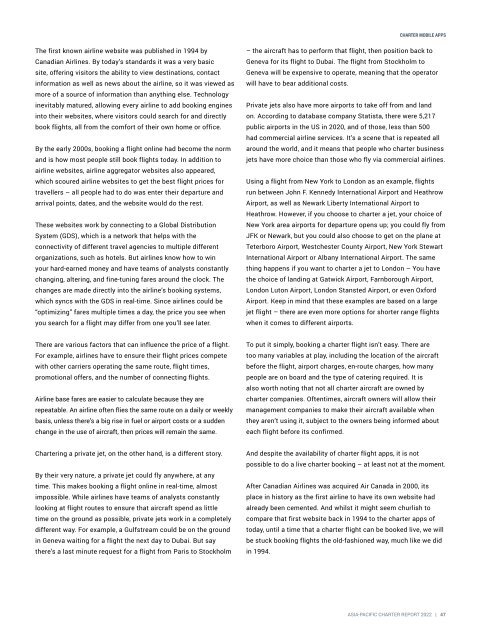Create successful ePaper yourself
Turn your PDF publications into a flip-book with our unique Google optimized e-Paper software.
CHARTER MOBILE APPS<br />
The first known airline website was published in 1994 by<br />
Canadian Airlines. By today’s standards it was a very basic<br />
site, offering visitors the ability to view destinations, contact<br />
information as well as news about the airline, so it was viewed as<br />
more of a source of information than anything else. Technology<br />
inevitably matured, allowing every airline to add booking engines<br />
into their websites, where visitors could search for and directly<br />
book flights, all from the comfort of their own home or office.<br />
By the early 2000s, booking a flight online had become the norm<br />
and is how most people still book flights today. In addition to<br />
airline websites, airline aggregator websites also appeared,<br />
which scoured airline websites to get the best flight prices for<br />
travellers – all people had to do was enter their departure and<br />
arrival points, dates, and the website would do the rest.<br />
These websites work by connecting to a Global Distribution<br />
System (GDS), which is a network that helps with the<br />
connectivity of different travel agencies to multiple different<br />
organizations, such as hotels. But airlines know how to win<br />
your hard-earned money and have teams of analysts constantly<br />
changing, altering, and fine-tuning fares around the clock. The<br />
changes are made directly into the airline’s booking systems,<br />
which syncs with the GDS in real-time. Since airlines could be<br />
“optimizing” fares multiple times a day, the price you see when<br />
you search for a flight may differ from one you’ll see later.<br />
– the aircraft has to perform that flight, then position back to<br />
Geneva for its flight to Dubai. The flight from Stockholm to<br />
Geneva will be expensive to operate, meaning that the operator<br />
will have to bear additional costs.<br />
Private jets also have more airports to take off from and land<br />
on. According to database company Statista, there were 5,217<br />
public airports in the US in 2020, and of those, less than 500<br />
had commercial airline services. It’s a scene that is repeated all<br />
around the world, and it means that people who charter business<br />
jets have more choice than those who fly via commercial airlines.<br />
Using a flight from New York to London as an example, flights<br />
run between John F. Kennedy International Airport and Heathrow<br />
Airport, as well as Newark Liberty International Airport to<br />
Heathrow. However, if you choose to charter a jet, your choice of<br />
New York area airports for departure opens up; you could fly from<br />
JFK or Newark, but you could also choose to get on the plane at<br />
Teterboro Airport, Westchester County Airport, New York Stewart<br />
International Airport or Albany International Airport. The same<br />
thing happens if you want to charter a jet to London – You have<br />
the choice of landing at Gatwick Airport, Farnborough Airport,<br />
London Luton Airport, London Stansted Airport, or even Oxford<br />
Airport. Keep in mind that these examples are based on a large<br />
jet flight – there are even more options for shorter range flights<br />
when it comes to different airports.<br />
There are various factors that can influence the price of a flight.<br />
For example, airlines have to ensure their flight prices compete<br />
with other carriers operating the same route, flight times,<br />
promotional offers, and the number of connecting flights.<br />
Airline base fares are easier to calculate because they are<br />
repeatable. An airline often flies the same route on a daily or weekly<br />
basis, unless there’s a big rise in fuel or airport costs or a sudden<br />
change in the use of aircraft, then prices will remain the same.<br />
To put it simply, booking a charter flight isn’t easy. There are<br />
too many variables at play, including the location of the aircraft<br />
before the flight, airport charges, en-route charges, how many<br />
people are on board and the type of catering required. It is<br />
also worth noting that not all charter aircraft are owned by<br />
charter companies. Oftentimes, aircraft owners will allow their<br />
management companies to make their aircraft available when<br />
they aren’t using it, subject to the owners being informed about<br />
each flight before its confirmed.<br />
<strong>Charter</strong>ing a private jet, on the other hand, is a different story.<br />
By their very nature, a private jet could fly anywhere, at any<br />
time. This makes booking a flight online in real-time, almost<br />
impossible. While airlines have teams of analysts constantly<br />
looking at flight routes to ensure that aircraft spend as little<br />
time on the ground as possible, private jets work in a completely<br />
different way. For example, a Gulfstream could be on the ground<br />
in Geneva waiting for a flight the next day to Dubai. But say<br />
there’s a last minute request for a flight from Paris to Stockholm<br />
And despite the availability of charter flight apps, it is not<br />
possible to do a live charter booking – at least not at the moment.<br />
After Canadian Airlines was acquired Air Canada in 2000, its<br />
place in history as the first airline to have its own website had<br />
already been cemented. And whilst it might seem churlish to<br />
compare that first website back in 1994 to the charter apps of<br />
today, until a time that a charter flight can be booked live, we will<br />
be stuck booking flights the old-fashioned way, much like we did<br />
in 1994.<br />
ASIA-PACIFIC CHARTER REPORT <strong>2022</strong> | 47

















